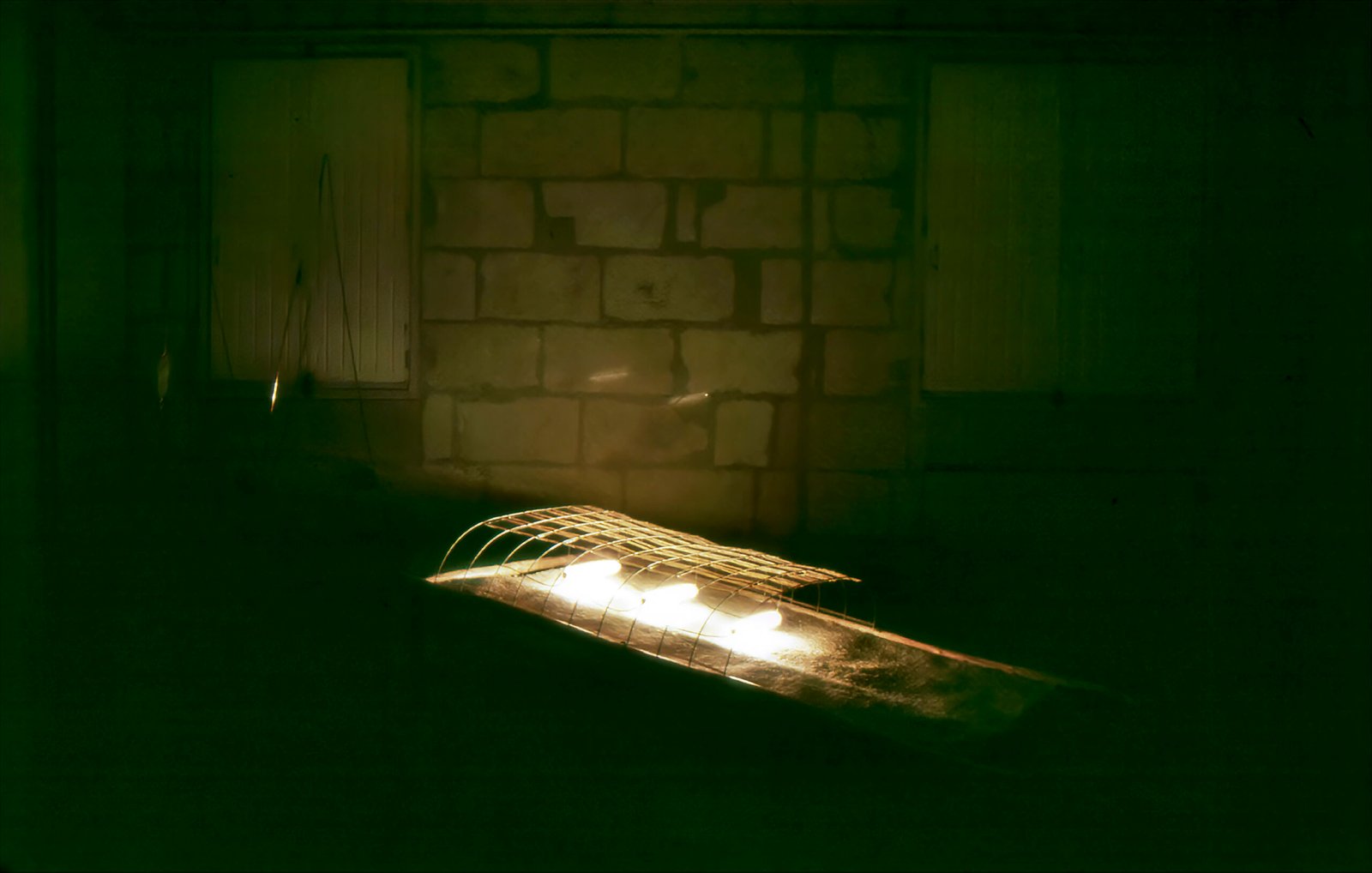An exhibition pavilion. Three rooms. The shutters are closed, and the lighting is absent. In each room, Alain Quesnel has arranged seemingly disparate elements that align, connect, and form three luminous variations of a stellar cartography. Singular electrical tinkering. Constellation figures. In any case, a staging of energy. Because it is indeed energy that he narrates: arched copper rods on cement pads, cascades of electrical wires (reminiscent of the folds in old paintings), « carts » of charred or white-sanded wood (housing glass, tiny bulbs, neon lights, or ash). Everything manifests circulation, flow, transformation, and even transmutation. The carts evoke wandering, signal nomadism. Cotton, itself a product of transformation, outlines the territory of virtual mutation, laying the bed for a potential, mysterious emergence in the muted glows: a sidereal womb, a heart of the Milky Way.
Even though the forms are allusive, there is no « naturalism » in Alain Quesnel’s work. He refuses to use raw materials that would suggest a search for origins, a nostalgia for primordial forces, or a « poor » aesthetic revealing either « the mark of a true relationship with the world » or a reactivation of expressive means. No. Here, wood, paper, copper, and bulbs coexist rather as substances in the sense of Beuys—where each element is utilized for its true nature, intrinsic power, perceptual complexity, and capacity to interact with others. Thus, paper carries within itself both use, wear, and memory, and the idea of a cycle: one is always reborn differently from one’s ashes. These elements can still be experienced as materials within an experimental field, a Zorio-like laboratory, a site of connections and communications—a territory of complicity.
Alchemy permeates this work. Each room of the pavilion is inhabited by a latent force with measured manifestations—delivered, revealed in brilliance; restrained, steady, almost lunar; or seeking its path within the limits of extinction. A force oscillating between eclipse and incandescence. Depending on the location, at each exhibition, the elements—though constant—shift and create new chains of relationships, new attractions. Their orientation matters. It can be cardinal: each installation, previously centered, takes on the form of a magnetic needle, without actually functioning as one. No single point is specifically indicated; everything happens between the materials, within their alignment. This topological structure, privileging hieratic face-to-face encounters and elegant movement, owes more to painting and drawing than to volume. It unfolds sideways, frontally, or through the rhythm of our movement. It never penetrates space. In this sense, Alain Quesnel’s approach to installation, in a contemporary context where category distinctions have faded, could fit the definition of installation as both a mode questioning space through object assemblies and a mode maintaining a dialogue with painting: objects extracted from the pictorial realm, stripped of flatness, not represented but simply presented.
Alain Quesnel arranges fabricated objects in space to reveal the energies and tensions present in painting. He materializes its rhythms and breath. He makes his dialogue tangible. That is what distinguishes him from the predecessors mentioned earlier. Even if his most recent works break from rigidity and invite a more initiatory journey—meandering in ways less immediately decipherable, where linearity, succession, and sequencing establish relationships between things—the setup is akin to writing. Our gaze operates as if reading a text, following the trajectory determined by the artist (in the last room, it escapes from the ground to extend onto the wall). Beuys and Zorio do not inscribe themselves within space; they push its boundaries, multiply it. They do not reveal space; they enact it. Their approach is conjunctive, immediate. They are sculptors. Here, the stance is entirely different—it takes the form of evocation, embraces the ephemeral, and plays decisively with the avatars and modulations of light. Generated by the works, this light subjects space to discretion—either through near-total erasure or through a restrained presence. It pinpoints, reveals, isolates these strange assemblages, elevating them to the status of markers, signs, milestones: three symbols marking a passage, three manifestations simultaneously different and alike, whose ambivalence (assisted ready-made vs. craftsmanship, line vs. volume…), indeterminacy, and shadowed zones (and the voids between them) allow for digressions and reveries. On the paths of conveyance.
To the discovery of other routes, tireless travelers—the way remains open.
Marie-Luce Thomas – 1993
Exposition Alain Quesnel – Pavillon Charles X – Saint-Cyr-sur-Loire – 1993
